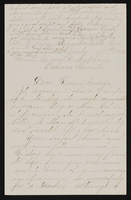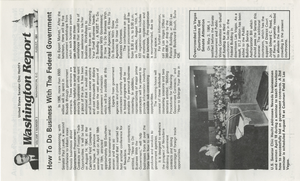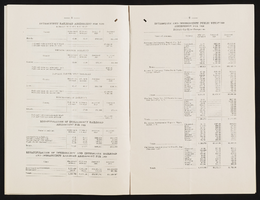Search the Special Collections and Archives Portal
Search Results

Photograph of a crowd gathered for the Los [sic] Vegas Democratic delegation for county division, Las Vegas (Nev.), 1900-1925
Date
Archival Collection
Description
Image

Letter (no envelope) from John M. Bunker, Bunkerville, Nevada to Mary E Syphus, Panaca, Nevada
Date
Archival Collection
Description
From the Syphus-Bunker Papers (MS-00169). The folder contains an original handwritten letter, a typed transcription of the same letter, and a copy of original letter attached.
Text
Elbert Edwards Photograph Collection
Identifier
Abstract
The Elbert Edwards Photograph Collection contains photographs of Nevada from 1852 to 1991. The collection has a wide variety of photographs, including: white pioneers and settlers; early Nevada towns; Nevada politicians; early Las Vegas landmarks; Boulder City schools; petroglyphs from Nevada's indigenous populations; Lost City and Lake Mead; railroads; the Hoover Dam (Boulder Dam); Basic Magnesium Inc. in Henderson, Nevada; geographical features; the Edwards family; and photographs of Elbert Edwards's participation in the Las Vegas Education Association and the Rotary Club.
Archival Collection

Interview with Navor Tito Valdez, June 20, 2005
Date
Archival Collection
Description
Text

Transcript of interview with Kevin T. Orrock by Claytee D. White, December 04, 2015
Date
Archival Collection
Description
Kevin T. Orrock, president of Summerlin and vice president of Master Planned Communities for The Howard Hughes Corp., has come full circle. Born in Pioche, Nevada, he spent his early years in the San Francisco Bay area and in Pittsburgh, Pennsylvania. Graduating from a small liberal arts college, he arrived in Las Vegas in 1974 with a degree in accounting and a teaching credential, finding work in the Desert Inn accounting department. Howard Hughes owned the Desert Inn, so from 1974 Orrock has consistently been in the employ of Howard Hughes, Summa Corporation, and Howard Hughes Corporation. Orrock later earned his M.B.A. at UNLV. In this interview, Orrock focuses on Summerlin, the 22,000-acre, award-winning, master-planned community on the west side of the Las Vegas Valley. He discusses Summerlin’s physical layout, its history, its development, and its future. He specifically credits Summa Corporation’s early visionaries John Goolsby and Will Lummis for having the foresight to sell some of the company’s land in order to build the financial foundation that, in turn, permitted Summerlin’s fifty-year development plan. He also talks about the development and future of Downtown Summerlin; its balance of private, charter, and public schools; and the ways the company selects its residential builders.
Text
Helen J. Stewart Photographs
Identifier
Abstract
The Helen J. Stewart Photographs depict the Stewart Family from approximately 1860 to 1950. The photographs primarily depict Helen J. Stewart and her children as well as the Stewart Ranch (also know as the Las Vegas Ranch) in Southern Nevada. The photographs include the early Las Vegas, Nevada town site, landscapes of Southern Nevada and the American Southwest, mines and mining camps, railroads and railroad workers, the Las Vegas Fort (also known as the Old Mormon Fort), hotels and early businesses in Las Vegas, Native Americans and Native American artifacts, and postcards.
Archival Collection



